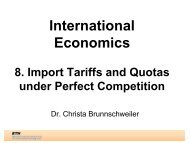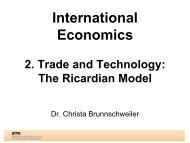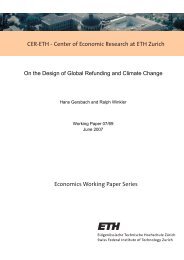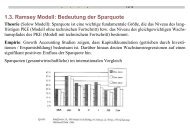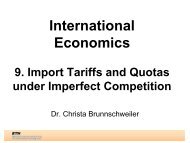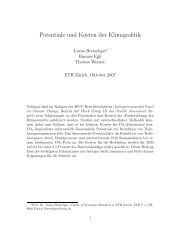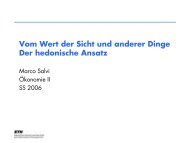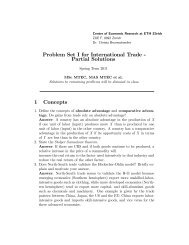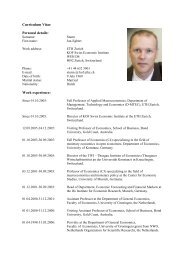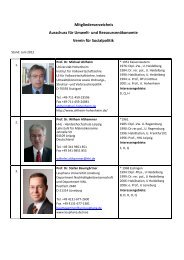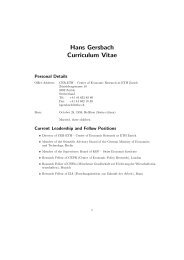The Dynamics of Economic Integration: Theory and Policy - CER-ETH
The Dynamics of Economic Integration: Theory and Policy - CER-ETH
The Dynamics of Economic Integration: Theory and Policy - CER-ETH
Create successful ePaper yourself
Turn your PDF publications into a flip-book with our unique Google optimized e-Paper software.
WIF - Institute <strong>of</strong> <strong>Economic</strong> Research<br />
<strong>Economic</strong>s Working Paper Series<br />
Eidgenössische Technische Hochschule Zürich<br />
Swiss Federal Institute <strong>of</strong> Technology Zurich
<strong>The</strong> <strong>Dynamics</strong> <strong>of</strong> <strong>Economic</strong><br />
<strong>Integration</strong>: <strong>The</strong>ory <strong>and</strong> <strong>Policy</strong> §<br />
forthcoming in: International <strong>Economic</strong>s <strong>and</strong> <strong>Economic</strong> <strong>Policy</strong><br />
Lucas Bretschger (<strong>ETH</strong> Zurich) <strong>and</strong><br />
Thomas M. Steger (<strong>ETH</strong> Zurich) ‡<br />
April 2004<br />
<strong>Integration</strong> affects economic growth mainly through two different<br />
channels: <strong>The</strong> scale-effect channel <strong>and</strong> the factor-reallocation<br />
channel. In order to investigate both channels within a unifying<br />
framework, we employ a simple descriptive growth model. <strong>The</strong><br />
scale-effect channel increases either the long-run growth rate or<br />
the level <strong>of</strong> the balanced growth path. <strong>The</strong> factor-reallocation<br />
channel is ambiguous. It is shown under which conditions this<br />
mechanism induces either a rise or a fall in the long-run growth<br />
rate. In addition, a number <strong>of</strong> policy conclusions are drawn.<br />
Keywords: International trade; economic integration; economic<br />
growth; scale effects; factor reallocation<br />
JEL Classification: F1 (Trade); O4 (<strong>Economic</strong> Growth)<br />
§ For helpful comments <strong>and</strong> suggestions we would like to thank Hannes Egli, Karen<br />
Pittel, Werner Röger <strong>and</strong> Sjak Smulders.<br />
‡ Corresponding author: <strong>ETH</strong> Zurich, WIF - Institute <strong>of</strong> <strong>Economic</strong> Research, <strong>ETH</strong><br />
Zentrum, WET D 6, CH-8092 Zurich, Tel. +41 (0)1 632 24 27, Fax +41 (0)1 632 13 62,<br />
steger@wif.gess.ethz.ch.<br />
1
1 Introduction<br />
<strong>The</strong> issue <strong>of</strong> economic integration is high on the political agenda. Examples<br />
<strong>of</strong> formal processes <strong>of</strong> economic integration comprise the formation <strong>of</strong> the<br />
European Union (EU), the current enlargement <strong>of</strong> the EU by Eastern European<br />
countries, the North American Free Trade Agreement (NAFTA), the<br />
attempt to establish a Free Trade Area <strong>of</strong> the Americas (FTAA) <strong>and</strong> the<br />
Association <strong>of</strong> South East Asian Nations (ASEAN). Beside these regional<br />
integration processes, there is the tendency <strong>of</strong> global economic integration<br />
driven by the World Trade Organization (WTO). In addition, there is substantial<br />
informal integration which is due to technological progress in the<br />
transportation <strong>and</strong> communication sector.<br />
<strong>Economic</strong> integration affects the participating economies in different<br />
ways. On the one h<strong>and</strong>, there are effects on the static allocation <strong>and</strong> hence<br />
direct effects on the income level. This aspect has been dealt with in the<br />
international trade literature. On the other h<strong>and</strong>, it is important to underst<strong>and</strong><br />
the dynamic implications <strong>of</strong> economic integration. This aspect was<br />
largely neglected for a long time but has recently experienced renewed attention<br />
in the wake <strong>of</strong> endogenous growth theory. In the meantime, there<br />
is a substantial literature dealing with the dynamic consequences <strong>of</strong> international<br />
trade on economic growth (e.g. Rivera-Batiz <strong>and</strong> Romer, 1991;<br />
Grossman <strong>and</strong> Helpman, 1991; Baldwin <strong>and</strong> Forslid, 2000). According to<br />
this literature, there are basically two major mechanisms through which<br />
economic integration affects the long-run evolution <strong>of</strong> an economy. First,<br />
we observe a "scale-effect channel" which relies on positive spill-over effects<br />
<strong>and</strong> increases the growth rate <strong>of</strong> the integrated economic area either permanently<br />
or temporarily. Second, there is a "factor-reallocation channel"<br />
which affects the share <strong>of</strong> resources allocated to the dynamic sector(s) <strong>of</strong> the<br />
economy <strong>and</strong> hence changes the growth rate. <strong>The</strong> models which underlie<br />
this str<strong>and</strong> <strong>of</strong> research are diverse <strong>and</strong> <strong>of</strong>ten quite complex. <strong>The</strong> paper at<br />
h<strong>and</strong> <strong>of</strong>fers a concise survey <strong>of</strong> this literature. This is achieved by employing<br />
a simple descriptive growth model, which is used as a unifying framework.<br />
<strong>The</strong> results <strong>of</strong> the empirical literature on the trade-growth nexus are<br />
mixed. Edwards (1998) <strong>and</strong> Dollar (1992) find evidence for a positive impact<br />
<strong>of</strong> international trade on growth. Concerning the European integration,<br />
Henrekson et al. (1997) find positive dynamic effects, while Vanhoudt (1999)<br />
rejects a positive impact on the growth rate. Badinger (2001) argues that<br />
the European integration has unfold a significant temporary growth effect.<br />
A more recent study which reports mixed evidence on the openness-growth<br />
2
elationship is Vamvadakis (2002). 1 We will argue that these ambiguous<br />
results are by no means surprising. According to our theoretical approach,<br />
they are explained by the fact that the two channels include different dynamic<br />
effects which can <strong>of</strong>fset each other.<br />
<strong>The</strong> rest <strong>of</strong> the paper is organized as follows. In Section 2, a simple<br />
descriptive growth model is set up. <strong>The</strong> scale-effect channel <strong>of</strong> economic<br />
integration on long-run growth is discussed in Section 3. In Section 4, the<br />
factor-reallocation channel is investigated. Finally, Section 5 provides a<br />
number <strong>of</strong> conclusions <strong>and</strong> some policy implications.<br />
2 A descriptive growth model<br />
In order to analyze the dynamic consequences <strong>of</strong> economic integration, we<br />
set up a descriptive growth model. <strong>The</strong> model is "descriptive" in the sense<br />
that we do not explicitly investigate the intertemporal consumption trade-<strong>of</strong>f<br />
<strong>and</strong> consequently do not analyze the determinants behind resource allocation<br />
decisions. Instead, we simply assume that preferences <strong>and</strong> technology are<br />
such that the representative agent wishes to allocate a positive amount <strong>of</strong><br />
resources to the dynamic sector. This is equivalent to saying that the growth<br />
condition is satisfied (i.e. the net marginal product <strong>of</strong> accumulable resource<br />
exceeds the time preference rate). In addition, we focus on the balanced<br />
growth equilibrium implying that the relative size <strong>of</strong> the consumption <strong>and</strong><br />
the dynamic sector is constant. This framework allows us to analyze the<br />
major consequences <strong>of</strong> economic integration on long-run growth within a<br />
unifying framework.<br />
<strong>The</strong> basic set-up is described by the following set <strong>of</strong> equations:<br />
Ẋ = bZM 1−γ<br />
X Xγ X<br />
(1)<br />
Z = X η (2)<br />
M X = M − M C (3)<br />
X X = X − X C , (4)<br />
where X denotes an accumulable resource (physical capital, technological<br />
knowledge, human capital), Ẋ the rate <strong>of</strong> change <strong>of</strong> X during a short period<br />
<strong>of</strong> time dt, M the amount <strong>of</strong> a primary resource (raw labor, l<strong>and</strong>), X X<br />
theamount<strong>of</strong>X allocated to the production <strong>of</strong> X, M X theamount<strong>of</strong>M<br />
1 Baldwin (2000) provides a survey <strong>of</strong> the empirical literature on openess <strong>and</strong> growth.<br />
3
allocated to the production <strong>of</strong> X <strong>and</strong> M C the amount <strong>of</strong> M allocated to the<br />
production <strong>of</strong> consumption goods. 1 Both M X <strong>and</strong> X X denote private inputs.<br />
In equation (1), Z denotes a public input (technological knowledge or public<br />
infrastructure) as determined by equation (2). This equation represents<br />
either a spill-over relation or may be interpreted as the provision <strong>of</strong> a taxedfinanced<br />
public good. Finally, b>0 is a constant technology parameter, γ<br />
(0 ≤ γ ≤ 1) the elasticity <strong>of</strong> X in X-production, 1 − γ the elasticity <strong>of</strong> M<br />
in X-production <strong>and</strong> η ≥ 0 gives the intensity <strong>of</strong> the spill-over effect.<br />
Equation (1) should be interpreted as a description <strong>of</strong> the dynamic sector<br />
<strong>of</strong> the economy. <strong>The</strong> "dynamic sector" is definedbythefollowingproperties.<br />
<strong>The</strong> growth rate <strong>of</strong> the accumulable resource produced by this sector pins<br />
down the growth rate <strong>of</strong> output. Moreover, a constant growth rate <strong>of</strong> this<br />
accumulable resource is usually achieved by holding the share <strong>of</strong> the private<br />
resources allocated to this sector constant. Hence, a constant share <strong>of</strong> the<br />
private inputs allocated to the dynamic sector leads to a constant growth<br />
rate <strong>of</strong> output. 2<br />
This formulation captures a large number <strong>of</strong> endogenous growth models.<br />
Specific examples<strong>of</strong>growthmodelswhichfit into this structure are<br />
Romer (1986), where X denotes physical capital <strong>and</strong> Z "knowledge" <strong>and</strong><br />
Barro (1990) with X denoting physical capital <strong>and</strong> Z public infrastructure<br />
provided by the government. In addition, there is a number <strong>of</strong> two-sector<br />
growth models which can be represented by this framework. For instance, in<br />
Romer (1990) <strong>and</strong> Grossman <strong>and</strong> Helpman (1991, Chapter 3), X represents<br />
"technology" (measured by the number <strong>of</strong> blueprints), γ is equal to zero<br />
<strong>and</strong> Z denotes technological knowledge (or knowledge capital). Similarly,<br />
in Jones (1995) X represents "technology" (γ =0)<strong>and</strong>Z is technological<br />
knowledge but the spill-over effect is restricted by η 0. 3 In Lucas (1988), X is (average) human capital while γ =1<br />
<strong>and</strong> η =0. 4<br />
1 In Section 4 we extend the basic framework to two consumption goods <strong>and</strong> two primary<br />
input factors.<br />
2 Moreover, for two-sector R&D-based growth models, Eicher <strong>and</strong> Turnovsky (1999,<br />
proposition 5) show that the long-run growth rate is exclusively determined by the structural<br />
characteristics <strong>of</strong> the sector which is not restricted to possess constant returns to<br />
scale in endogenous (private <strong>and</strong> public) resources.<br />
3 Eicher <strong>and</strong> Turnovsky (1999, Section 3) generalize the Jones (1995) model in that<br />
physical capital is allowed to be productive in R&D (labelled the ”hybrid model”).<br />
4 Since γ =1, M does not enter the production function <strong>of</strong> the dynamic sector <strong>and</strong><br />
consequently there is no scale effect in this model. <strong>The</strong> scale effect will be discussed<br />
extensively below.<br />
4
<strong>The</strong> growth rate <strong>of</strong> X can be readily derived from (1), (2), (3) <strong>and</strong> (4)<br />
to read as follows:<br />
g X := Ẋ µ 1−γ µ γ<br />
X = b MX<br />
M 1−γ XX<br />
X η+γ−1 (5)<br />
M<br />
X<br />
Holding M constant, equation (5) shows that growth <strong>of</strong> X (<strong>and</strong> hence<br />
the growth rate <strong>of</strong> output) ceases in the long run provided that η + γ 0. For<br />
a balanced growth path to be feasible, the restriction η+γ
Provided that there is only one accumulable resource, which is produced<br />
using the same technology as consumption, final output can be written as:<br />
Y = Ẋ + C = bZM1−γ X<br />
Xγ X + bZM1−γ C<br />
X γ C = bM1−γ X γ+η , (8)<br />
<strong>and</strong> the growth rate <strong>of</strong> final output is, accordingly, given by:<br />
g Y =(1− γ) g M +(γ + η) g X . (9)<br />
Next, we compare the growth rates before integration (the growth rate<br />
under autarky) to the growth rate <strong>of</strong> the integrated economies (the growth<br />
rate under free trade). Specifically, to derive the dynamic impact <strong>of</strong> opening<br />
an economy to trade, we analyze the equilibrium obtained in a hypothetical<br />
"integrated world economy", see Dixit <strong>and</strong> Norman (1980, chapter 4). In this<br />
reference point, goods, factors <strong>and</strong> knowledge are assumed to be fully mobile.<br />
<strong>The</strong> decisive insight is to observe that the result for the integrated economy<br />
is reproduced through free goods trade under certain conditions. In general,<br />
these conditions are that factor prices are equalized <strong>and</strong> preferences are<br />
internationally identical <strong>and</strong> homothetic. In the dynamic context, we have<br />
additionally to assume that Z in (1) <strong>and</strong> (2) is an international public good,<br />
see Grossman <strong>and</strong> Helpman (1991, p. 183). <strong>The</strong>n, the trading equilibrium<br />
replicates the integrated world equilibrium for our descriptive growth model,<br />
even when the input factors M <strong>and</strong> X are internationally immobile. This<br />
will be assumed throughout the paper. With Z as an international public<br />
good, growth rates are equal in all trading economies. <strong>The</strong> impact <strong>of</strong> trade<br />
<strong>and</strong> growth can thus simply be derived from comparing the growth rate<br />
under autarky to growth in the integrated world economy.<br />
Inthecase<strong>of</strong>Z being a national public good, factor prices are not<br />
equalized; the same holds true for large international differences in factor<br />
endowments. In these cases, factors have an incentive to be internationally<br />
mobile. <strong>The</strong> dynamic effects <strong>of</strong> capital <strong>and</strong> labor mobility under these conditions<br />
are treated in Smulders (2004) <strong>and</strong> Bretschger (2001b), respectively.<br />
In general, Z can be viewed as (i) a national public good, which is available<br />
within the border <strong>of</strong> the economic area under study (usually within a state);<br />
(ii) an international public good, which is available within an integrated<br />
economy (a free trade area) <strong>and</strong> (iii) a global public good, which is available<br />
everywhere on the globe irrespective <strong>of</strong> any barriers. 6 In order to focus on<br />
6 Jones (2002) investigates an R&D-based growth model in which technological knowledge<br />
represents a global public good.<br />
6
the two integration channels mentioned in the introduction, we will restrict<br />
the analysis to the second case.<br />
Considering the determinants <strong>of</strong> the long-run growth rate on the righth<strong>and</strong><br />
side <strong>of</strong> equation (6) shows that economic integration may affect the<br />
long-run growth rate either via the size <strong>of</strong> the relevant economic area as<br />
measured by M or via the intersectoral allocation <strong>of</strong> resources as captured by<br />
M X<br />
M<br />
<strong>and</strong> X X<br />
X<br />
. In what follows we will, accordingly, distinguish two channels<br />
through which economic integration influences long-run growth:<br />
1. <strong>The</strong> scale-effect channel: <strong>The</strong> scale (size) <strong>of</strong> the integrated economic<br />
unit may affect the speed <strong>of</strong> long-run economic growth. We label this<br />
property the "first-order scale effect". In addition, it might be the case<br />
that the level <strong>of</strong> the balanced growth path increases with the size <strong>of</strong><br />
the relevant economic unit. This property is denoted as "second-order<br />
scale effect".<br />
2. <strong>The</strong> resource-reallocation channel: <strong>The</strong> share <strong>of</strong> resources allocated<br />
to the dynamic sector may be affected by economic integration. <strong>The</strong><br />
specific role <strong>of</strong> the dynamic sector in the economy implies that this<br />
resource reallocation has an effect on the long-run rate <strong>of</strong> growth.<br />
In what follows, we will investigate the different channels using the descriptive<br />
growth model set up above.<br />
3 <strong>The</strong> scale-effect channel<br />
Most applied reports on economic integration contain the proposition "bigger<br />
is better". This phrase expresses the view that there is a positive scale<br />
effect on long-run economic growth. In the following, this statement is qualified<br />
with the help <strong>of</strong> our approach.<br />
In this section, we assume that the economies under study are perfectly<br />
identical, i.e. we impose symmetry. Each trading economy is assumed to be<br />
fully specialized in the production <strong>of</strong> a country-specific consumer good C.<br />
This simplifying assumption allow us to abstract from a change in relative<br />
prices <strong>and</strong> induced resource reallocations from the consumption goods sector<br />
to the dynamic sector (or vice versa). An appropriate interpretation is that<br />
the analysis mainly applies to the integration between similar countries. In<br />
the subsequent section we relax this assumption <strong>and</strong> extend the analysis <strong>of</strong><br />
economic integration between unequal economies.<br />
7
Let us at first consider the different scale effects implied by the general<br />
model set up in Section 2. <strong>The</strong> case g M =0requires η + γ =1for balanced<br />
growth to be feasible <strong>and</strong> positive. In this case, equation (5) immediately<br />
gives the long-run growth rate <strong>of</strong> the economy under study as (restated for<br />
convenience):<br />
µ 1−γ µ γ MX<br />
g X = b<br />
M 1−γ XX<br />
. (10)<br />
M<br />
X<br />
<strong>The</strong> scale effect is represented by the term M 1−γ in equation (10). <strong>The</strong><br />
larger the amount <strong>of</strong> the primary resource M, the higher is the long-run<br />
growth rate. We label this effect the first-order scale effect. Moreover,<br />
the right-h<strong>and</strong> side <strong>of</strong> equation (5) in Section 2 immediately points to the<br />
(necessary) conditions for a first-order scale effect. First, there is a primary<br />
input M (measuring the scale <strong>of</strong> the economy) which can be productively<br />
employed in the dynamic sector producing the accumulable resource X, i.e.<br />
1−γ >0. 7 Second, as assumed in deriving equation (10), the productivity <strong>of</strong><br />
the resource X in X-production (comprising private <strong>and</strong>/ or public effects)<br />
must be sufficiently large, i.e. η + γ ≥ 1. Since we focus on balanced growth<br />
paths, we exclude the case η + γ > 1. In summary, the general set-up<br />
employed here points to two conditions which must hold for the presence <strong>of</strong><br />
a first-order scale effect: (i) 1 − γ>0 <strong>and</strong> (ii) η + γ =1.<br />
<strong>The</strong> economic intuition behind the first-order scale effectisthatalarger<br />
amount <strong>of</strong> the primary resource M enables an economy to produce more<br />
<strong>of</strong> the accumulable resource X. Moreover, the accumulation <strong>of</strong> X rises the<br />
productivity <strong>of</strong> the primary resource M. Provided that the impact <strong>of</strong> X on<br />
the productivity <strong>of</strong> M (which may occur either via positive spill-over effects<br />
or via private effects) is sufficiently large (i.e. η + γ =1), this positive<br />
feedback mechanism generates a first-order scale effect. As a consequence,<br />
a rise in the size <strong>of</strong> the economy fosters long-run economic growth.<br />
Let us turn to the second case, which is characterized by g M > 0. Fora<br />
balanced growth path to be feasible, the restriction η + γ
scale effect in the sense that the level <strong>of</strong> the balanced growth path is positively<br />
related to the size <strong>of</strong> the relevant economic area as measured by M.<br />
We label this effect the "second-order scale effect". 8 Even when the permanent<br />
growth rate <strong>of</strong> an economy is not affected by a first-order scale effect,<br />
welfare can increase considerably due to higher income levels.<br />
We now analyze the dynamic consequences <strong>of</strong> economic integration by<br />
using the reference point <strong>of</strong> the integrated world economy as stated above.<br />
Consider k economies which are perfectly identical. This means that there is<br />
no incentive for international groods trade. <strong>The</strong> growth rate <strong>of</strong> every single<br />
economy under autarky is given by equation (10). In an integrated area<br />
comprising k economies, the output <strong>of</strong> the dynamic sector within a single<br />
economy (indexed by i) isgivenby:<br />
µ 1−γ µ γ µ<br />
MX,i<br />
Ẋ i = b<br />
M 1−γ XX,i kP<br />
η<br />
i<br />
X i X γ i<br />
M i<br />
X . (11)<br />
i i=1<br />
µ<br />
Notice that with Z representing an international public good Z i =<br />
kP<br />
η<br />
X i holds for each single country. By employing the symmetry assumption<br />
(i.e. X i = kX) <strong>and</strong> taking equation (10) into account,<br />
i=1<br />
kP<br />
the<br />
i=1<br />
growth rate <strong>of</strong> the world economy, that is the growth rate <strong>of</strong> each economy<br />
under integration, becomes: 9<br />
g int<br />
X<br />
= k η g aut<br />
X . (12)<br />
According to (12), the integrated economy grows at a rate which is by<br />
afactork η ≥ 1 larger than the growth rate under autarky. <strong>The</strong> reason<br />
behind this result lies neither in goods trade nor in the increased number <strong>of</strong><br />
consumers but in the fact that an integrated economy can use the common<br />
pool <strong>of</strong> the public good, i.e. Z i =(kX) η . Wethushaveafirst-order scale<br />
effect, the strength <strong>of</strong> which is given by the factor k η . Obviously, the higher<br />
the number <strong>of</strong> economies joining an integration k <strong>and</strong> the larger the spill-over<br />
effect η, the stronger is the growth enhancing effect <strong>of</strong> economic integration.<br />
On the other h<strong>and</strong>, assuming η + γ < 1 (asintheso-called"semiendogenous<br />
growth models") there is a second-order scale effect. 10 This can<br />
8 Jones (2003) uses the expressions ”weak” <strong>and</strong> ”strong” scale effects.<br />
9 For details see the supplement to this paper, which is available at<br />
www.wif.ethz.ch/resec/people/tsteger/dyn_int_supplement.pdf.<br />
10 <strong>The</strong> expression semi-endogenous growth model refers to the fact that public policy is<br />
9
e readily recognized by focusing on the growth rate <strong>of</strong> a single economy as<br />
given by equation (5), which is restated for convenience:<br />
g aut<br />
X i<br />
= b<br />
µ 1−γ<br />
MXi<br />
M 1−γ<br />
i<br />
M i<br />
µ<br />
XXi<br />
X i<br />
γ<br />
X η+γ−1<br />
i<br />
. (13)<br />
Provided that η + γ 0 in order to explain sustained growth. Moreover,<br />
along a balanced growth path, the rate <strong>of</strong> growth <strong>of</strong> M 1−γ<br />
i<br />
must equal the<br />
rate <strong>of</strong> decay <strong>of</strong> X η+γ−1<br />
i<br />
such that the right-h<strong>and</strong> side <strong>of</strong> equation (13) is<br />
constant. Assume now that such an economy joins an integration. <strong>The</strong><br />
growth rate immediately after integration is given by:<br />
g int<br />
X i<br />
= b<br />
µ 1−γ<br />
MXi<br />
M 1−γ<br />
i<br />
M i<br />
µ<br />
XXi<br />
X i<br />
γ<br />
k η X i η+γ−1 . (14)<br />
Hence, immediately after joining the integration, we have the same result<br />
as for the endogenous growth model above, namely gX<br />
int = kη gX aut.<br />
<strong>The</strong><br />
expression exhibits that the growth rate initially jumps by the factor k η .<br />
Moreover, equation (14) shows that an economic integration has the same<br />
effect as a positive <strong>and</strong> permanent shock to the productivity parameter b.<br />
However, since we have assumed that η + γ
Backus et al. (1992) conduct cross-sectional studies using different measures<br />
for the scale <strong>of</strong> an economy (e.g. aggregate GDP; manufacturing output;<br />
number <strong>of</strong> scientists, engineers <strong>and</strong> technicians; R&D expenditure) deriving<br />
mixed results. Overall, the evidence on the first-order scale effect is mixed. 11<br />
On the other h<strong>and</strong>, there is a clear empirical evidence in favor <strong>of</strong> secondorder<br />
scale effects. Specifically, employing a dynamic growth accounting<br />
model advocated by Temple (1999), Badinger (2001) investigates the consequences<br />
<strong>of</strong> economic integration in Europe from 1950 until 2000 for economic<br />
growth. By distinguishing explicitly between global integration (the GATT<br />
process) <strong>and</strong> regional integration (the formation <strong>of</strong> the European Union) the<br />
author rejects a permanent growth effect <strong>of</strong> economic integration (first-order<br />
scale effect) but finds solid empirical support for a temporary growth effect<br />
(second-order scale effect): "If no integration had taken place since 1950,<br />
GDP per capita <strong>of</strong> the EU would be approximately one fifth smaller today.<br />
In terms <strong>of</strong> growth this implies that without integration, the average growth<br />
rate per annum over the period 1950 to 2000 would have been lower by 0.4<br />
percentage points. Our results suggest that the bulk <strong>of</strong> these effects (70 to 90<br />
percent) can be traced back to increases in efficiency (technology-led growth),<br />
while integration-induced investment-led growth played only a rather small<br />
role." Badinger (2001, p. 26). It should be noticed that the stated reasoning<br />
is perfectly in line with the theory laid out above.<br />
4 <strong>The</strong> factor-reallocation channel<br />
4.1 Unequal economies<br />
In the previous section, we have considered the dynamic consequences <strong>of</strong> economic<br />
integration <strong>of</strong> perfectly symmetric economies. <strong>The</strong> symmetry assumption<br />
allows to isolate the scale effect <strong>and</strong> to abstract from other channels,<br />
which may affect long-run growth. However, a number <strong>of</strong> important economic<br />
consequences <strong>of</strong> economic integration (or globalization) results from<br />
asymmetries between the economies under study. Differences in factor endowments<br />
induce a change in relative goods <strong>and</strong> factor prices. <strong>The</strong>se price<br />
changes cause a myriad <strong>of</strong> factor substitutions associated with a process <strong>of</strong><br />
intersectoral reallocation <strong>of</strong> resources. Specifically, consider two asymmetric<br />
economies that join an integration such that trade in goods is completely<br />
11 A comprehensive summary <strong>of</strong> the empirical evidence on the scale effect can be found<br />
in Jones (2003).<br />
11
liberalized but factors are still immobile across international borders (this<br />
is the st<strong>and</strong>ard set-up considered in trade theory). As a consequence <strong>of</strong><br />
trade in goods, relative goods prices change. According to the st<strong>and</strong>ard<br />
Heckscher-Ohlin theory <strong>of</strong> international trade, every economy specializes in<br />
the production <strong>of</strong> the good which uses the relatively abundant factor intensively.<br />
A shift in the composition <strong>of</strong> the dem<strong>and</strong> for input factors in turn<br />
induces a change in relative factor prices. Finally, <strong>and</strong> most importantly, if<br />
the price <strong>of</strong> the factor used intensively in the dynamic sector changes, the<br />
induced process <strong>of</strong> factor reallocations affects the dynamic sector <strong>and</strong> hence<br />
long-run growth.<br />
<strong>The</strong>se mechanisms have been discussed in the literature on trade <strong>and</strong><br />
growth (Grossman <strong>and</strong> Helpman, 1990; Grossman <strong>and</strong> Helpman, 1991, Chapter<br />
4 <strong>and</strong> 5; Baldwin <strong>and</strong> Forslid, 2000). <strong>The</strong> underlying general equilibrium<br />
models are, however, quite complex since the analysis must deal with an endogenous<br />
growth model <strong>of</strong> an open economy producing two traded goods<br />
<strong>and</strong> employing two input factors. In what follows, we use the descriptive<br />
growth model set up above to study the determinants <strong>of</strong> factor reallocations<br />
<strong>and</strong> the resulting growth effects in response to economic integration.<br />
We apply the method <strong>of</strong> Jones (1965) to analyze the determinants <strong>of</strong><br />
factor reallocations from the consumption good sectors to the dynamic sector<br />
(or vice versa). On this occasion, we consider two consumption goods,<br />
which are labelled C <strong>and</strong> D <strong>and</strong> are produced in both countries. In order<br />
to apply the Jones (1965) procedure, we must have a model which is "static"<br />
in a technical sense, meaning that the economic structure along the<br />
balanced growth path can be described by a set <strong>of</strong> static equations. At<br />
the economic level, the model still describes a dynamic economy. This requirement<br />
is perfectly in line with our focus on the long-run consequences<br />
<strong>of</strong> economic integration. <strong>The</strong>refore, we formulate the model in stationary<br />
variables, which are constant along the balanced growth path.<br />
4.2 Basic factor-reallocation equation<br />
In this section, the basic factor-reallocation equation is derived. <strong>The</strong> economic<br />
interpretation is then given in Section 4.3. <strong>The</strong> technically less interested<br />
reader may want to read this section less carefully; nonetheless, the<br />
basic set-up <strong>and</strong> the notation should be noticed.<br />
With respect to output technologies we assume the following functional<br />
σc<br />
σc<br />
σc−1<br />
σc−1<br />
forms: Ẋ = bM 1X X, C = (ε 1 M + ε 2 M ) α(σc−1)<br />
σc X 1−α <strong>and</strong> D =<br />
1C<br />
2C<br />
12
σ d<br />
σ d<br />
σ<br />
(ε 1 M d −1<br />
1D<br />
+ε σ<br />
2M d −1<br />
σ d X 1−β with 0 ≤ ε 1 ,ε 2 ,α,β ≤ 1 <strong>and</strong> σ c ,σ d > 0. 12<br />
Since it is instructive to consider two types <strong>of</strong> private inputs, we distinguish<br />
between skilled labor M 1 <strong>and</strong> unskilled labor M 2 , which are supplied in<br />
fixed quantities. <strong>The</strong> constant elasticity <strong>of</strong> substitution between M 1 <strong>and</strong> M 2<br />
in C production is σ c <strong>and</strong> in D production is σ d . We define the following<br />
X<br />
scale-adjusted variables x :=<br />
exp(g X t) , c := C<br />
exp(g C t) , d := D<br />
exp(g D t) ,where<br />
g X , g C ,<strong>and</strong>g D denote the long-run growth rate <strong>of</strong> the respective variable.<br />
By construction, the scale-adjusted variables (x, c, d) are constant along the<br />
balanced growth path. After conducting an appropriate adjustment <strong>of</strong> scale,<br />
we get the following system <strong>of</strong> equations (details are contained in the supplement<br />
to this paper):<br />
g X = bM 1X (15)<br />
2D ) β(σ d −1)<br />
c =(ε 1 M<br />
d =(ε 1 M<br />
σc<br />
σc−1<br />
1C<br />
σ d<br />
σ d −1<br />
1D<br />
+ ε 2 M<br />
+ ε 2M<br />
σc<br />
σc−1<br />
2C<br />
σ d<br />
σ d −1<br />
) α(σ c−1)<br />
σc x 1−α (16)<br />
2D ) β(σ d −1)<br />
σ d x 1−β . (17)<br />
<strong>The</strong> economy under study can be considered to produce three "goods",<br />
i.e. the growth rate g X (which pins down g C <strong>and</strong> g D ), indicating the slope<br />
<strong>of</strong> the balanced growth path, <strong>and</strong> two tradeable consumption goods c <strong>and</strong><br />
d, which yield the level <strong>of</strong> the balanced growth path (in terms <strong>of</strong> C <strong>and</strong> D).<br />
This set <strong>of</strong> equations captures the intertemporal consumption trade-<strong>of</strong>f. <strong>The</strong><br />
system <strong>of</strong> equations (15), (16) <strong>and</strong> (17) represents in fact a static system,<br />
which allows us to apply the methodology <strong>of</strong> Jones (1965) to conduct a<br />
convenient comparative static analysis. 13<br />
Once more, equation (15) indicates that the consequences <strong>of</strong> economic<br />
integration on the long-run growth rate must be due to permanent changes<br />
in the factor input M 1X . Hence, we focus on the determinants <strong>of</strong> a change<br />
in M 1X due to economic integration. Beside a change in the overall stock <strong>of</strong><br />
M 1 (the scale effect), a change in the intersectoral allocation pattern affects<br />
M 1X . This factor-reallocation effect is governed by a change in the factor<br />
rewards <strong>of</strong> skilled labor w 1 <strong>and</strong> unskilled labor w 2 ,whichcanbecalculated<br />
by again using the integrated world equilibrium.<br />
By defining the input requirement for one unit <strong>of</strong> the respective output<br />
a 1j := M 1j<br />
j<br />
for j = c, d, g X , one may state the economy’s resource constraints<br />
12 To simplify matters, X is assumed to represent a public input. It could also represent<br />
a private input.<br />
13 Since we treat factor prices w 1 <strong>and</strong> w 2 as exogenous, the model under study should<br />
be considered as a partial equilibrium framework.<br />
13
as follows:<br />
M 1 = a 1c c + a 1d d + a 1x g X (18)<br />
M 2 = a 2c c + a 2d d + a 2x g X . (19)<br />
Expressing (18) in percentage terms yields: 14<br />
cM 1 = λ 1c (ba 1c + bc)+λ 1d (ba 1d + b d)+λ 1x (ba 1x + bg X ). (20)<br />
where λ 1j for j = c, d, g X denote factor shares, i.e. λ 1j := a 1j j<br />
M 1<br />
= M 1j<br />
M 1<br />
for j = c, d, g X .Bynotingthat c M 1x = ba 1x + bg X (resulting from a 1x = M 1x<br />
g X<br />
)<br />
<strong>and</strong> c M 1 =0(i.e. the economy-specific amount<strong>of</strong>skilledlaborisassumed<br />
to be constant) it follows that the preceding equation can be expressed as<br />
(see mathematical supplement for details):<br />
cM 1x = − λ 1c<br />
(ba 1c + bc) − λ 1d<br />
(ba 1d + d).<br />
λ 1x λ b (21)<br />
1x<br />
Equation (21) shows that the (proportional) change in M 1X results from<br />
factor reallocations between the dynamic sector <strong>and</strong> the consumption goods<br />
sectors. Specifically, the first term indicates a reallocation between the c-<br />
sector <strong>and</strong> the dynamic sector, while the second term points to reallocations<br />
between the d-sector the dynamic sector. Moreover, every reallocation effect<br />
comprises two components: <strong>The</strong> first component consists in a substitution<br />
effect as indicated by ba 1c <strong>and</strong> ba 1d , whereas the second component represents<br />
an output effect as indicated by bc <strong>and</strong> d. b We will now analyze the<br />
determinants behind the reallocation effectinmoredetail.<br />
<strong>The</strong> first step is to express ba 1c (ba 1d )<strong>and</strong>bc ( d) b in terms <strong>of</strong> exogenous<br />
variables. Let us start with ba 1c (ba 1d ). Minimization <strong>of</strong> unit cost (a 1c w 1 +<br />
a 2c w 2 ) yields ba 1c θ 1c + ba 2c θ 2c =0<strong>and</strong> hence we get ba 2c = − θ 1c<br />
θ 2c<br />
ba 1c ,where<br />
θ 1c := a 1c w 1<br />
p c<br />
<strong>and</strong> θ 2c := a 2c w 2<br />
p c<br />
. 15 Moreover, the elasticities <strong>of</strong> substitution<br />
can be expressed as σ c := a 1c−a 2c<br />
w 2 − w 1<br />
<strong>and</strong> σ d := a 1d−a 2d<br />
w 2 − w 1<br />
. Substituting ba 2c in<br />
σ c ( bw 2 − bw 1 )=ba 1c − ba 2c (resulting from the preceding definition) finally<br />
yields (the same reasoning applies to ba 1d ; see the appendix for details):<br />
ba 1c = −θ 2c σ c ( bw 1 − bw 2 ) (22)<br />
ba 1d = −θ 2d σ d ( bw 1 − bw 2 ). (23)<br />
14 This is achieved by totally differentiating equation (18).<br />
15 Minimization <strong>of</strong> unit cost is implied by pr<strong>of</strong>it maximization.<br />
14
We now turn to bc ( d). b Under perfect competition in the final output<br />
sector (consumption goods sector), the following relation must hold: p c =<br />
a 1c w 1 +a 2x w 2 . Totally differentiating this equation (<strong>and</strong> dividing by p c )one<br />
can readily derive:<br />
bp c = θ 1c bw 1 + θ 2c bw 2 (24)<br />
From p c c = const., which holds due to the scale-adjustment, it follows<br />
that (the same reasoning applies to d): b 16<br />
bc = −bp c = −θ 1c bw 1 − θ 2c bw 2 (25)<br />
bd = −bp d = −θ 1d bw 1 − θ 2d bw 2 (26)<br />
Choosing M 1 as the numeraire such that w 1 =1<strong>and</strong> bw 1 =0<strong>and</strong> inserting<br />
equations (22), (23), (25) <strong>and</strong> (26) into (21) finally gives (see the supplement<br />
for details):<br />
cM 1x = − P λ 1j<br />
(σ j − 1)θ 2j bw, (27)<br />
λ 1x<br />
j=c,d<br />
where w := w 2<br />
w 1<br />
. Equation (27) decomposes a change in M 1x ( c M 1x )<br />
into two reallocation effects: the reallocation between the c-sector <strong>and</strong> the<br />
dynamic sector or between the d-sector <strong>and</strong> the dynamic sector.<br />
4.3 <strong>Economic</strong> interpretation<br />
We now discuss the economic intuition behind the basic factor-reallocation<br />
equation (27). We compare again the integrated world economy with the<br />
economy under autarky to obtain the effects <strong>of</strong> trade on long-run growth.<br />
To explain the basic mechanism, we assume that, as an example, w falls<br />
( bw
This output effect increases the amount <strong>of</strong> M 1 allocated to the c-sector <strong>and</strong><br />
the d-sector (i.e. M 1c <strong>and</strong> M 1d rise). Full employment then immediately<br />
implies that M 1x falls. In addition, a decrease in w induces a substitution <strong>of</strong><br />
M 1 by M 2 in c-production <strong>and</strong> d-production. This substitution effect leads<br />
to a decrease in M 1j (j = c, d) <strong>and</strong> hence an increase in M 1x . <strong>The</strong> overall<br />
effect <strong>of</strong> a falling w on M 1x , therefore, depends on the size <strong>of</strong> the elasticities<br />
<strong>of</strong> substitution. More specifically, if σ j < 1 (j = c, d), the output effect<br />
dominates the substitution effect <strong>and</strong> hence M 1x falls.<br />
<strong>The</strong> analysis <strong>of</strong> the factor reallocation channel points to the fact that the<br />
Heckscher-Ohlin logic can be applied to the analysis <strong>of</strong> the long-run growth<br />
effects <strong>of</strong> economic integration. From the perspective <strong>of</strong> an economy which<br />
is relatively abundantly endowed with skilled labor, economic integration<br />
means that w = w 2<br />
w 1<br />
falls (unskilled labor becomes cheaper relative to skilled<br />
labor). This change in the relative factor price induces both an output effect<br />
(M 1j rises <strong>and</strong> M 1x falls) <strong>and</strong> a substitution effect (M 1j falls <strong>and</strong> M 1x rises).<br />
Provided that skilled <strong>and</strong> unskilled labor are poor substitutes in the consumption<br />
goods sector (σ j < 1), the reallocation effect leads to a decrease in<br />
skilled labor allocated to the dynamic sector <strong>and</strong>, as a consequence, growth<br />
decreases as well.<br />
Overall, the partial equilibrium framework employed above has demonstrated<br />
an important general result <strong>of</strong> the literature on endogenous growth<br />
<strong>and</strong> trade according to which international trade may reduce the growth<br />
rates <strong>of</strong> the economies involved (Grossman <strong>and</strong> Helpman, 1990).<br />
In addition, this str<strong>and</strong> <strong>of</strong> the literature draws the conclusion that international<br />
trade leads to coincidence in growth rates. It should be noted that<br />
the growth rate coincidence in response to international trade critically relies<br />
on the assumption <strong>of</strong> spill-over being international in scope. If, on the other<br />
h<strong>and</strong>, the spill-over is completely national, then there may be divergence in<br />
growth rates, despite <strong>of</strong> international trade (see Feenstra, 1996).<br />
<strong>The</strong> analysis above was based on a st<strong>and</strong>ard spill-over relation, which<br />
assumes that intertemporal spill-over effects result from the accumulation<br />
<strong>of</strong> the accumulable resource only. In contrast, one could sensibly argue that<br />
the spill-over on X accumulation results also from usual business activities<br />
approximated by C <strong>and</strong> D. <strong>The</strong> spill-over relation equation (2) may then<br />
be accordingly expressed as Z = C α D β X η . Inthiscase,itcanbeshown<br />
that the condition for the dominance <strong>of</strong> the substitution effect (σ c > 1) is<br />
attenuated <strong>and</strong> given by σ c > 1/(1 + α + β) (Bretschger, 2001a). Thus<br />
as soon as α, β > 0, the integration <strong>of</strong> a skilled labor rich country with<br />
16
an unskilled labor abundant country is less likely to entail negative growth<br />
effects.<br />
5 <strong>Policy</strong> implications<br />
<strong>The</strong>re are a number <strong>of</strong> policy implications with respect to economic integration<br />
<strong>and</strong> long-run growth. <strong>The</strong>se follow from the analysis <strong>of</strong> the scale effect<br />
<strong>and</strong> the factor reallocation effect.<br />
<strong>Policy</strong> implications resulting from the scale effect<br />
<strong>The</strong> analysis <strong>of</strong> economic integration based on theoretical growth models<br />
points to the fact that there are scale effects associated with economic<br />
integration. Whether these scale effects are first-order scale effects or secondorder<br />
scale effects is largely an empirical matter. In fact, there is some evidence<br />
against first-order scale effects but solid empirical support for secondorder<br />
scale effects. Since the speed <strong>of</strong> convergence towards the new balanced<br />
growth path (i.e. the post-integration balanced growth path) can be fairly<br />
low, the second-order scale effect may be strong. 19<br />
<strong>The</strong> relation g int<br />
X<br />
= kη g aut<br />
X<br />
indicates that the scale effect is larger, the<br />
higher the number <strong>of</strong> countries joining an integration k <strong>and</strong> the stronger<br />
the spill-over effect η; this applies to both first-order <strong>and</strong> second order scale<br />
effects. <strong>The</strong> first determinant is clearly under control <strong>of</strong> public policy. To<br />
some extent this implication might appear trivial but it is worth being noted<br />
that the scale effect is a clear argument for worldwide economic integration<br />
instead <strong>of</strong> regional integration. In the context <strong>of</strong> policy reports, the scale<br />
<strong>of</strong> an economy is <strong>of</strong>ten measured by the number <strong>of</strong> consumers, which is<br />
considered as a proxy for the size <strong>of</strong> the market. Other measures for the<br />
scale <strong>of</strong> an economy are the overall stock <strong>of</strong> the primary input (labor or<br />
human capital). 20 It is important to realize that the relevant scale in this<br />
context is the stock <strong>of</strong> the factor used intensively in the dynamic sector <strong>and</strong><br />
not a general measure <strong>of</strong> economic size.<br />
On the other h<strong>and</strong>, the strength <strong>of</strong> the spill-over effect (being a technology<br />
parameter) is usually considered as not being under control <strong>of</strong> public<br />
19 In this respect it should be noted that lowering the speed <strong>of</strong> convergence would<br />
strengthen the second-order scale effect.<br />
20 Human capital should not be viewed as a primary resource but instead as an accumulable<br />
input factor. Nonetheless, in Romer (1990) there is a primary input denoted as<br />
human capital. Moreover, in empirical studies the number <strong>of</strong> scientists <strong>and</strong> the level <strong>of</strong><br />
GDP have also been used as measures <strong>of</strong> the macroeconomic scale (Backus et al., 1992).<br />
17
policy. 21 Nonetheless,thereisanimportantpointtonoticeatthisstage.<br />
<strong>The</strong> scale effect resulting from theoretical growth models should be interpreted<br />
as the potential benefit <strong>of</strong> economic integration, which is not realized<br />
automatically simply by removing formal barriers <strong>of</strong> exchange (goods,<br />
ideas, people). 22 Instead, economic integration probably represents only a<br />
necessary condition for taking full advantage <strong>of</strong> the scale effect. It appears<br />
appropriate to assume that individuals need to actively acquire the benefits<br />
associated with the "spill-over effect". Put differently, the spill-over<br />
effect can be considered as a technological opportunity <strong>of</strong> taking advantage<br />
<strong>of</strong> activities conducted by other agents. In this perspective, there are costs<br />
associated with the exploitation <strong>of</strong> the spill-over effect. <strong>The</strong> government<br />
should accordingly aim at reducing the costs <strong>of</strong> taking full advantage <strong>of</strong> the<br />
spill-over effect. Examples are communication networks, language training,<br />
exchange programmes etc. In this respect there is a clear requirement for<br />
future research investigating the individual costs <strong>and</strong> incentives for taking<br />
advantage <strong>of</strong> international spill-overs.<br />
<strong>Policy</strong> implications resulting from factor reallocations<br />
<strong>The</strong> analysis <strong>of</strong> the factor reallocation channel points to the fact that<br />
economic integration may reduce the amount <strong>of</strong> resources devoted to the<br />
dynamic sector in some <strong>of</strong> the participating economies. As a consequence,<br />
the long-run growth rate in the economies under study decreases. More<br />
specifically, provided that the consumption goods sector exhibits an elasticity<br />
<strong>of</strong> substitution between skilled <strong>and</strong> unskilled labor smaller than unity<br />
<strong>and</strong> the trading partner is abundantly endowed with unskilled labor, a reallocation<br />
<strong>of</strong> skilled labor from the dynamic sector to the consumption goods<br />
sector results. Whether the conditions mentioned above are fulfilled need to<br />
be checked empirically.<br />
<strong>The</strong> factor reallocation channel is instructive from a theoretical perspective<br />
since it shows the possibility <strong>of</strong> a reduction in the growth rate due to<br />
economic integration. As demonstrated, the magnitude <strong>of</strong> this effect is ambiguous.<br />
Nevertheless, empirical estimates <strong>of</strong> the elasticity <strong>of</strong> substitution<br />
show that this parameter may well lie below unity when the difference <strong>of</strong><br />
qualification between the two types <strong>of</strong> labor is large (e.g. Hamermesh, 1993,<br />
Chapter 3). <strong>The</strong>re is, <strong>of</strong> course, a symmetric effect going on in the economy<br />
<strong>of</strong> the trading partner. Moreover, an economy joining an integration <strong>and</strong><br />
experiencing a slowdown in the growth rate need not be worse <strong>of</strong> in terms<br />
21 <strong>The</strong> parameter η stems from the spill-over technology.<br />
22 Rivera-Batitz <strong>and</strong> Romer (1991) distinguish between trade in goods <strong>and</strong> flow <strong>of</strong> ideas.<br />
18
<strong>of</strong> welfare. This is due to a favorable terms <strong>of</strong> trade effect, which allows the<br />
slowly growing economy to import the goods produced by the fast-growing<br />
trading partner at continuously falling prices.<br />
<strong>The</strong> analysis above supposes that full employment holds. In the longrun,<br />
this assumption might be considered as justified. In the medium term,<br />
however, there are considerable doubts, especially in the case <strong>of</strong> continental<br />
Europe. If the full employment condition is not met, a decrease in the labor<br />
dem<strong>and</strong> <strong>of</strong> one sector is not exactly <strong>of</strong>fsetbyanincreaseinthelabordem<strong>and</strong><br />
<strong>of</strong> the other sector. For a skilled-labor rich economy, this would mean that<br />
labor released from the dynamic sector is not fully integrated in consumer<br />
goods production.<br />
<strong>The</strong> simple framework used above points to the fact that the intersectoral<br />
allocation <strong>of</strong> (skilled) labor is important for long run growth. <strong>The</strong> sectoral<br />
structure <strong>of</strong> an economy is heavily influenced by public policy. <strong>The</strong>refore,<br />
the question arises how economic integration might change the policies that<br />
aim at the sectoral structure <strong>of</strong> an economy. Considering the case <strong>of</strong> the<br />
enlargement <strong>of</strong> the European Union, there is the chance <strong>of</strong> a reconstruction<br />
<strong>of</strong> those policies that aim at a conservation <strong>of</strong> the economic structure. This<br />
strategy should clearly foster economic growth in the long run.<br />
References<br />
[1] Backus, D., K., P. J. Kehoe, <strong>and</strong> T. J. Kehoe, In Search <strong>of</strong> Scale Effects<br />
in Trade <strong>and</strong> Growth, Journal <strong>of</strong> <strong>Economic</strong> <strong>The</strong>ory, 1992, 58, 377-409.<br />
[2] Badinger, H., Growth Effects <strong>of</strong> <strong>Economic</strong> <strong>Integration</strong> - <strong>The</strong> Case <strong>of</strong> the<br />
EU Member States (1950 - 2000), IEF Working Paper No. 40, Wien,<br />
December 2001.<br />
[3] Baldwin, R. <strong>and</strong> R. Forslid, Trade Liberalisation <strong>and</strong> Endogenous<br />
Growth: A q-<strong>The</strong>ory Approach, Journal <strong>of</strong> International <strong>Economic</strong>s,<br />
2000, 50, 2 , 497-517.<br />
[4] Baldwin, R., Openness <strong>and</strong> growth: What’s the empirical relationship?,<br />
NBER Working Paper No. 9578.<br />
[5] Barro, R., Government Spending in a Simple Model <strong>of</strong> Endogenous<br />
Growth, Journal <strong>of</strong> Political, 1990, 98, S103-S125.<br />
19
[6] Bretschger, L., On the Predictability <strong>of</strong> Knowledge Formation: the Tortuous<br />
Link Between Regional Specialisation <strong>and</strong> Development, Journal<br />
<strong>of</strong> <strong>Economic</strong>s, 73, 2001a, 247-274.<br />
[7] Bretschger, L., Labor Supply, Migration <strong>and</strong> Long-Term Development,<br />
Open Economies Review, 2001b, 12, 1, 5-27.<br />
[8] Dixit, A. K. <strong>and</strong> V. Norman (1980), <strong>The</strong>ory <strong>of</strong> International Trade,<br />
Cambridge: Cambridge University Press.<br />
[9] Dollar, D., Outward-Oriented Developing Countries Really Do Grow<br />
More Rapidly: Evidence from 95 LDCs, <strong>Economic</strong> Development <strong>and</strong><br />
Cultural Change, 1992, 523-544.<br />
[10] Edwards, Sebastian, Openness, Productivity <strong>and</strong> Growth: What Do<br />
We Really Know?, <strong>Economic</strong> Journal, 1998, 108, 383-398.<br />
[11] Eicher, T. S. <strong>and</strong> S. J. Turnovsky, Non-scale Models <strong>of</strong> <strong>Economic</strong><br />
Growth, <strong>Economic</strong> Journal, 1999, 109, 394-415.<br />
[12] Feenstra, R.C., Trade <strong>and</strong> uneven growth, Journal <strong>of</strong> Development <strong>Economic</strong>s,<br />
49, 1996, 229-256.<br />
[13] Grossman, G. M. <strong>and</strong> E. Helpman, Comparative Advantage <strong>and</strong> Longrun<br />
Growth, American <strong>Economic</strong> Review, 1990, 80, 796-815.<br />
[14] Grossman, G.M., E. Helpman, Innovation <strong>and</strong> Growth in the Global<br />
Economy, MIT Press, Cambridge Mass, 1991.<br />
[15] Hamermesh, D., Labor Dem<strong>and</strong>, Princeton University Press, 1993,<br />
Princeton, NJ.<br />
[16] Henrekson, M., J. Torstensson, R. Torstensson, Growth Effects <strong>of</strong> European<br />
<strong>Integration</strong>, European <strong>Economic</strong> Review, 1997, 41, 1537-1557.<br />
[17] Howitt, P., Steady Endogenous Growth with Population <strong>and</strong> R&D Inputs<br />
Growing, Journal <strong>of</strong> Political Economy, 1999, 107, 715-730.<br />
[18] Jones, R., <strong>The</strong> Structure <strong>of</strong> Simple General Equilibrium Models, Journal<br />
<strong>of</strong> Political Economy, 1965, 73, 557-572.<br />
[19] Jones, C. I., R&D-based models <strong>of</strong> economic growth, Journal <strong>of</strong> Political<br />
Economy, 1995, 103, 759-784.<br />
20
[20] Jones, C. I., Sources <strong>of</strong> U.S. <strong>Economic</strong> Growth in a World <strong>of</strong> Ideas,<br />
American <strong>Economic</strong> Review, 2002, 92, 220-239.<br />
[21] Jones, C. I., Growth <strong>and</strong> Ideas, 2003, Draft for the "H<strong>and</strong>book <strong>of</strong> <strong>Economic</strong><br />
Growth", P. Aghion <strong>and</strong> S. Durlauf (eds.), Elsevier, Amsterdam.<br />
[22] Koopmans, T. C., On the concept <strong>of</strong> optimal economic growth, in: <strong>The</strong><br />
Econometric Approach to Development Planning, Amsterdam, North<br />
Holl<strong>and</strong>, 1965.<br />
[23] Kremer, M. , Population Growth <strong>and</strong> Technological Change: One Million<br />
B.C. to 1990, Quarterly Journal <strong>of</strong> <strong>Economic</strong>s, 1993, 108, 681-716.<br />
[24] Lucas, R. E. Jr., On the Mechanics <strong>of</strong> <strong>Economic</strong> Development, Journal<br />
<strong>of</strong> Monetary <strong>Economic</strong>s, 22, 1988, 3-42.<br />
[25] Rivera-Batiz, L. A. <strong>and</strong> P. M. Romer, <strong>Economic</strong> <strong>Integration</strong> <strong>and</strong> Endogenous<br />
Growth, Quarterly Journal <strong>of</strong> <strong>Economic</strong>s, 1991, 106, 531-555.<br />
[26] Romer, P. M., Increasing Returns <strong>and</strong> Long-Run Growth, Journal <strong>of</strong><br />
Political Economy, 1986, 94, 6, 1002-1037.<br />
[27] Romer, P. M., Endogenous technological change, Journal <strong>of</strong> Political<br />
Economy, 1990, 98, 71-101.<br />
[28] Segerstrom, P., Endogenous Growth Without Scale Effects, American<br />
<strong>Economic</strong> Review, 1998, 88, 1290-1310.<br />
[29] Smulders, S., Convergence, Growth <strong>and</strong> the Welfare Gains <strong>of</strong> Capital<br />
Mobility, International <strong>Economic</strong>s <strong>and</strong> <strong>Economic</strong> <strong>Policy</strong>, 2004, 1, 2+3.<br />
[30] Smulders, S., Th. van de Klundert, Imperfect Competition, Concentration<br />
<strong>and</strong> Growth with Firm-specific R&D, European <strong>Economic</strong> Review,<br />
1995, 39, 139-160.<br />
[31] Solow, R.M., A Contribution to the <strong>The</strong>ory <strong>of</strong> <strong>Economic</strong> Growth, Quarterly<br />
Journal <strong>of</strong> <strong>Economic</strong>s, 1956, 70, 65-94.<br />
[32] Temple, J., <strong>The</strong> New Growth Evidence, Journal <strong>of</strong> <strong>Economic</strong> Literature,<br />
1999, 37, 112-156.<br />
[33] Young, A., Growth without Scale Effects, Journal <strong>of</strong> Political Economy,<br />
1998, 106, 41-63.<br />
21
[34] Peretto, P., Technological Change <strong>and</strong> Population Growth, Journal <strong>of</strong><br />
<strong>Economic</strong> Growth, 1998, 3, 283-311.<br />
[35] Vamvakidis, A., How Robust is the Growth-Openness Connection? Historical<br />
Evidence, Journal <strong>of</strong> <strong>Economic</strong> Growth, 2002, 7, 57-80.<br />
[36] Vanhoudt, P., Did the European Unification Induce <strong>Economic</strong> Growth?<br />
In Search <strong>of</strong> Scale Effects <strong>and</strong> Persistent Changes, Weltwirtschaftliches<br />
Archiv, 1999, 135, 193-220.<br />
22




